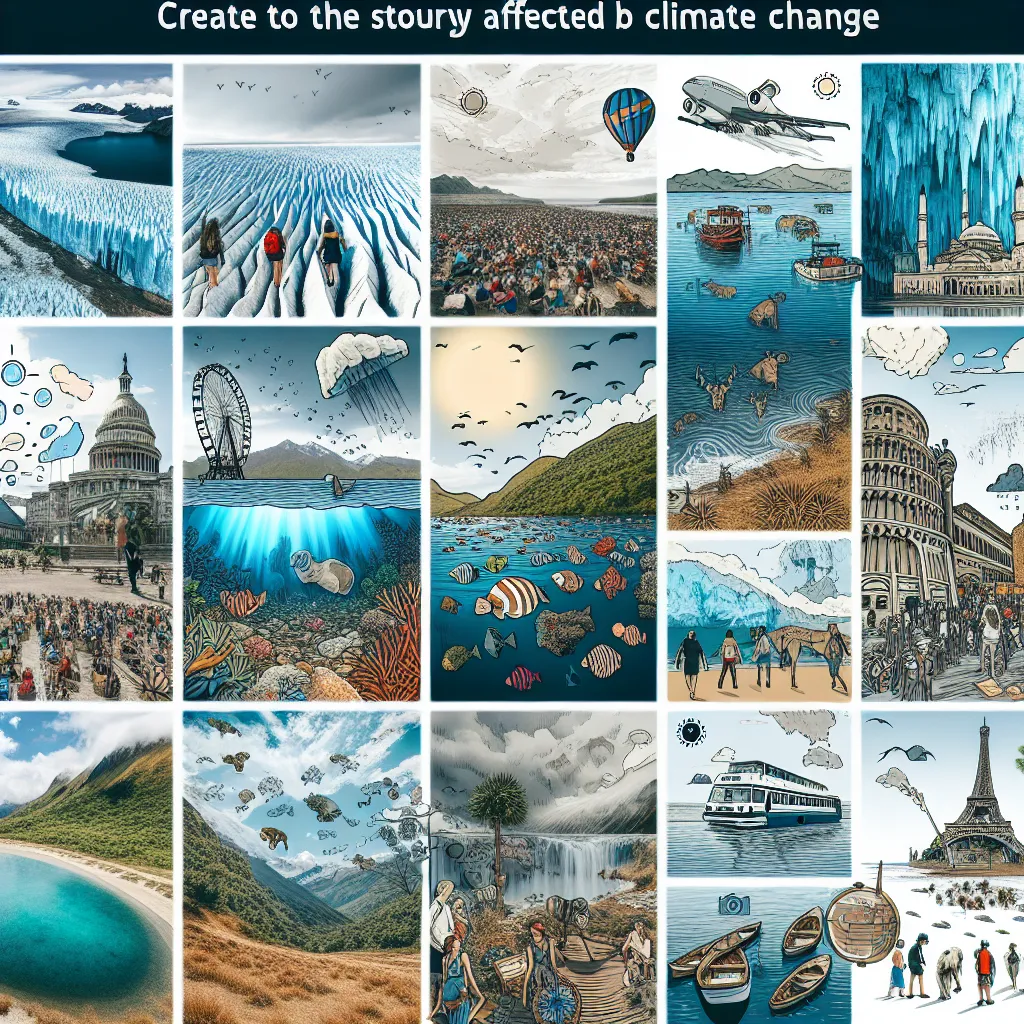Are you preparing for the IELTS exam and looking to improve your reading skills? In this article, we’ll explore a practice test focusing on the impact of climate change on global tourism. As an experienced IELTS instructor, I’ll guide you through a complete IELTS Reading test, including passages, questions, and answers, to help you understand the format and enhance your performance.
 Climate change impact on tourism
Climate change impact on tourism
Introduction to the Test
The IELTS Reading test consists of three passages of increasing difficulty, followed by a series of questions. Today’s practice test focuses on “The Impact of Climate Change on Global Tourism,” a topic that’s both relevant and challenging. Let’s dive into the passages and questions.
Passage 1 (Easy Text): Climate Change and Tourism – An Overview
Climate change is rapidly becoming one of the most significant challenges facing the global tourism industry. As temperatures rise and weather patterns shift, many popular tourist destinations are experiencing dramatic changes that affect their appeal and accessibility. From melting glaciers in the Alps to rising sea levels threatening coastal resorts, the impacts of climate change are reshaping the tourism landscape.
Tourism is a major contributor to global economic growth, accounting for approximately 10% of global GDP. However, it is also highly vulnerable to climate change impacts. Extreme weather events, such as hurricanes and heatwaves, can disrupt travel plans and damage infrastructure. Changes in temperature and precipitation patterns can alter the attractiveness of destinations, potentially leading to shifts in tourist flows.
The relationship between climate change and tourism is complex and bidirectional. While tourism is affected by climate change, it also contributes to the problem through greenhouse gas emissions from transportation and accommodation. This creates a challenging situation where the industry must adapt to changing conditions while also working to reduce its own environmental impact.
Despite these challenges, some destinations are finding new opportunities in the changing climate. For example, some northern regions are experiencing longer summer seasons, potentially attracting more visitors. Additionally, there is growing interest in “last-chance tourism,” where travelers visit endangered destinations before they disappear or change irreversibly.
As the effects of climate change become more pronounced, the tourism industry will need to adapt and innovate. This may involve developing more sustainable practices, diversifying offerings, and working closely with local communities to ensure resilience in the face of environmental changes.
Questions 1-5: Multiple Choice
Choose the correct letter, A, B, C, or D.
-
According to the passage, climate change is affecting tourism by:
A) Increasing the number of tourists globally
B) Changing the appeal and accessibility of destinations
C) Improving transportation infrastructure
D) Reducing the cost of travel -
The tourism industry accounts for approximately:
A) 5% of global GDP
B) 10% of global GDP
C) 15% of global GDP
D) 20% of global GDP -
The relationship between climate change and tourism is described as:
A) Unidirectional
B) Insignificant
C) Bidirectional
D) Beneficial -
“Last-chance tourism” refers to:
A) Budget travel options
B) Visiting endangered destinations
C) Eco-friendly tourism
D) Adventure tourism -
The passage suggests that the tourism industry’s response to climate change should include:
A) Ignoring environmental concerns
B) Focusing solely on profit
C) Adapting and innovating
D) Reducing global travel
Questions 6-10: True/False/Not Given
Do the following statements agree with the information given in the passage? Write:
TRUE if the statement agrees with the information
FALSE if the statement contradicts the information
NOT GIVEN if there is no information on this
- Rising temperatures are causing glaciers in the Alps to melt.
- All tourist destinations are negatively affected by climate change.
- The tourism industry is the largest contributor to greenhouse gas emissions.
- Northern regions may benefit from longer summer seasons due to climate change.
- The tourism industry is not taking any steps to address climate change impacts.
Passage 2 (Medium Text): Adaptation Strategies in the Tourism Sector
As the global tourism industry grapples with the impacts of climate change, adaptation strategies have become a crucial focus for destinations and businesses alike. These strategies aim to reduce vulnerability to climate-related risks while also capitalizing on potential opportunities that may arise from changing environmental conditions.
One key adaptation strategy is the diversification of tourism offerings. Many destinations are expanding beyond their traditional attractions to reduce dependence on climate-sensitive activities. For example, ski resorts facing shorter snow seasons are investing in year-round attractions such as mountain biking trails and alpine coasters. Coastal areas threatened by sea-level rise are developing inland attractions and promoting cultural tourism to complement their beach offerings.
Another important approach is the implementation of climate-resilient infrastructure. This includes measures such as flood protection systems for coastal hotels, improved water management in drought-prone areas, and the use of heat-resistant materials in construction. Such investments not only protect assets but also ensure the safety and comfort of visitors in the face of extreme weather events.
The concept of “adaptive tourism” is gaining traction, where travel experiences are designed to be flexible and responsive to changing environmental conditions. This might involve dynamic pricing models that adjust to weather forecasts or the development of alternative itineraries that can be quickly implemented in case of disruptions.
Technological innovations are playing a significant role in adaptation efforts. Advanced weather forecasting systems help tourism operators make informed decisions, while virtual and augmented reality experiences offer new ways to showcase destinations that may be at risk or temporarily inaccessible due to climate impacts.
Collaboration between the tourism industry, local communities, and governments is essential for effective adaptation. Many destinations are developing comprehensive climate action plans that involve all stakeholders in the decision-making process. This collaborative approach ensures that adaptation strategies are holistic and consider the needs of both the industry and local populations.
Education and awareness-raising among tourists are also crucial components of adaptation strategies. By informing visitors about the impacts of climate change and encouraging responsible travel practices, the industry can foster a more sustainable and resilient form of tourism.
While adaptation is necessary, it’s important to note that it goes hand in hand with mitigation efforts. The tourism sector is increasingly focusing on reducing its carbon footprint through measures such as investment in renewable energy, promotion of low-carbon transportation options, and implementation of waste reduction programs.
As climate change continues to reshape the global landscape, the ability of the tourism industry to adapt will be critical to its long-term sustainability and success. By embracing innovation, fostering collaboration, and prioritizing sustainability, the sector can work towards a more resilient future in the face of environmental challenges.
Questions 11-15: Matching Headings
Match the following headings to the correct paragraphs in the passage. Write the correct number (i-x) next to questions 11-15.
i. The role of technology in tourism adaptation
ii. Diversifying tourism offerings
iii. The importance of stakeholder collaboration
iv. Climate-resilient infrastructure development
v. Balancing adaptation with mitigation efforts
vi. The concept of adaptive tourism
vii. Economic impacts of climate change on tourism
viii. Educating tourists about climate change
ix. Global warming and its effects on biodiversity
x. The future of sustainable tourism practices
- Paragraph 2: __
- Paragraph 3: __
- Paragraph 4: __
- Paragraph 5: __
- Paragraph 6: __
Questions 16-20: Sentence Completion
Complete the sentences below using NO MORE THAN THREE WORDS from the passage for each answer.
- Ski resorts are investing in attractions like mountain biking trails to compensate for __.
- Climate-resilient infrastructure includes measures such as __ for coastal hotels.
- __ is a concept where travel experiences are designed to be flexible and responsive to environmental changes.
- Virtual and augmented reality experiences offer new ways to showcase destinations that may be __ due to climate impacts.
- The tourism sector is focusing on reducing its __ through various sustainability measures.
Passage 3 (Hard Text): The Economic Implications of Climate Change on Global Tourism
The intricate relationship between climate change and the global tourism industry extends far beyond environmental concerns, encompassing significant economic implications that reverberate throughout the world economy. As one of the largest and fastest-growing economic sectors globally, tourism’s vulnerability to climate change poses substantial risks to economic stability and growth in many regions.
The economic impacts of climate change on tourism are multifaceted and geographically diverse. In some areas, climate-induced changes may lead to the extension of peak tourist seasons, potentially boosting revenues. Conversely, other regions may face shortened seasons or the complete loss of their primary attractions, resulting in severe economic downturns. For instance, low-lying island nations, heavily reliant on beach tourism, face existential threats from rising sea levels and increased storm intensity, which could decimate their tourism-dependent economies.
The ski industry serves as a poignant example of the economic challenges posed by climate change. Reduced snowfall and shorter winters in many traditional ski destinations have necessitated significant investments in artificial snow-making equipment and the development of alternative attractions. These adaptations, while necessary for survival, entail substantial costs that can erode profit margins and potentially lead to increased prices for consumers, thereby affecting demand.
Coastal destinations, which account for a significant portion of global tourism revenues, are particularly vulnerable to the economic impacts of climate change. Sea-level rise, coastal erosion, and the increased frequency of extreme weather events pose direct threats to infrastructure, beaches, and marine ecosystems. The cost of protecting and restoring these assets is immense, placing a heavy burden on both public and private sectors. Moreover, the perceived risk of visiting such destinations may lead to a decline in tourist numbers, further exacerbating economic challenges.
The insurance industry plays a crucial role in the economic landscape of tourism under climate change. As climate-related risks increase, insurance premiums for tourism businesses in vulnerable areas are likely to rise significantly. In some cases, certain risks may become uninsurable, leaving businesses and destinations exposed to potentially catastrophic losses. This scenario could lead to a reallocation of investment away from high-risk areas, fundamentally altering the global tourism map.
Climate change is also influencing tourist behavior and preferences, with economic ramifications. There is a growing trend towards “climate-conscious tourism,” where travelers consider the environmental impact of their choices. This shift may benefit destinations and businesses that invest in sustainability and low-carbon operations, while those perceived as environmentally irresponsible may suffer economic losses. Additionally, concerns about carbon footprints may lead to a preference for shorter-haul travel, potentially redistributing tourism income from long-haul to short-haul destinations.
The economic impacts extend to associated industries as well. Agriculture, fisheries, and local crafts, which often form an integral part of the tourism experience and supply chain, may be affected by climate change, indirectly impacting tourism revenues. Furthermore, the potential for climate-induced migration could lead to changes in local labor markets, affecting the availability and cost of workforce in tourism-dependent areas.
Adaptation and mitigation strategies, while necessary, come with their own economic considerations. Investments in climate-resilient infrastructure, diversification of tourism products, and transition to low-carbon operations require significant capital expenditure. While these investments may secure long-term sustainability, they can pose short-term financial challenges, particularly for small and medium-sized enterprises that form the backbone of the tourism industry in many regions.
The interplay between climate change, tourism, and economic systems is complex and dynamic. As the effects of climate change intensify, there is an urgent need for comprehensive economic modeling and policy frameworks that can guide adaptive strategies and ensure the resilience of tourism-dependent economies. This may involve reassessing traditional economic indicators and incorporating climate risk assessments into investment decisions and economic planning.
In conclusion, the economic implications of climate change on global tourism are profound and far-reaching. While presenting significant challenges, this scenario also offers opportunities for innovation, sustainable development, and the creation of more resilient economic models. The ability of the tourism industry and associated economies to navigate these changes will be crucial in shaping the future of global tourism and its role in the world economy.
Questions 21-26: Matching Information
Match the following statements (A-H) with the correct paragraph (21-26) in the passage. Write the correct letter A-H next to questions 21-26. NB: You may use any letter more than once.
A. The impact of climate change on tourist preferences and behavior
B. The vulnerability of coastal tourism to climate change effects
C. The role of insurance in the tourism industry’s climate risk management
D. The economic challenges faced by the ski industry due to climate change
E. The potential redistribution of tourism income due to climate concerns
F. The impact of climate change on industries associated with tourism
G. The investment required for adaptation and mitigation strategies
H. The diverse economic impacts of climate change on different regions
- Paragraph 2: __
- Paragraph 3: __
- Paragraph 4: __
- Paragraph 5: __
- Paragraph 6: __
- Paragraph 7: __
Questions 27-32: Summary Completion
Complete the summary below using words from the box. Write the correct letter A-L next to questions 27-32.
A. uninsurable
B. resilient
C. sustainable
D. catastrophic
E. multifaceted
F. artificial
G. vulnerable
H. existential
I. economic
J. environmental
K. coastal
L. global
The economic implications of climate change on tourism are (27)____ and vary across different regions. Some areas may benefit from extended tourist seasons, while others face (28)____ threats to their tourism-dependent economies. The ski industry, for example, has had to invest in (29)____ snow-making equipment to adapt to shorter winters. (30)____ destinations are particularly (31)____ to climate change impacts, facing significant costs for protection and restoration. The insurance industry is also affected, with some risks becoming potentially (32)____, which could lead to a redistribution of tourism investments globally.
Questions 33-40: Yes/No/Not Given
Do the following statements agree with the claims of the writer in the passage? Write:
YES if the statement agrees with the claims of the writer
NO if the statement contradicts the claims of the writer
NOT GIVEN if it is impossible to say what the writer thinks about this
- Climate change will have uniformly negative economic impacts on all tourism destinations.
- The ski industry has successfully adapted to climate change without any economic challenges.
- Rising sea levels pose a significant threat to the tourism economies of low-lying island nations.
- Insurance premiums for tourism businesses in climate-vulnerable areas are likely to decrease.
- There is a growing trend towards more environmentally conscious tourism choices among travelers.
- Climate change will not affect the labor markets in tourism-dependent areas.
- Small and medium-sized enterprises in the tourism industry may face financial difficulties in implementing climate adaptation strategies.
- Traditional economic indicators are sufficient for assessing the impact of climate change on tourism economies.
Answer Key
Passage 1:
- B
- B
- C
- B
- C
- TRUE
- FALSE
- NOT GIVEN
- TRUE
- FALSE
Passage 2:
- ii
- iv
- vi
- i
- iii
- shorter snow seasons
- flood protection systems
- Adaptive tourism
- at risk or temporarily inaccessible
- carbon footprint
Passage 3:
- H
- D
- B
- C
- A
- F
- E
- H
- F
- K
- G
- A
- NO
- NO
- YES
- NO
- YES
- NOT GIVEN
- YES
- NO
Tips for Improving Your IELTS Reading Score
-
Practice time management: The IELTS Reading test is time-pressured, so practice completing similar-length passages and questions within the given time frame.
-
Improve your skimming and scanning skills: These techniques will help you quickly locate specific information in the text.
-
Expand your vocabulary: Focus on academic and topic-specific vocabulary to better understand complex texts.
-
Read actively: Engage with the text by highlighting key points and making brief notes.
-
Familiarize yourself with question types: Practice with all types of questions that appear in the IELTS Reading test.
-
Pay attention to context: Understanding the overall context can help you infer meanings of unfamiliar words.
-
Don’t get stuck: If you’re unsure about a question, move on and come back to it later if time allows.
-
Read the instructions carefully: Make sure you understand what each question is asking before answering.
-
Review your answers: If time permits, go back and check your answers for any obvious mistakes.
-
Practice regularly: Consistent practice with various topics will improve your reading speed and comprehension.
By following these tips and practicing regularly with tests like the one provided here, you can significantly improve your performance in the IELTS Reading test. Remember, understanding the impact of climate change on global tourism is not only crucial for your IELTS success but also for your awareness of this important global issue.
For more information on related topics, you might find these articles helpful:
- How to Address the Environmental Impact of Deforestation
- [The Impact of Climate Change on Coastal Cities](https://www.ielts.net/the-impact-of-climate


